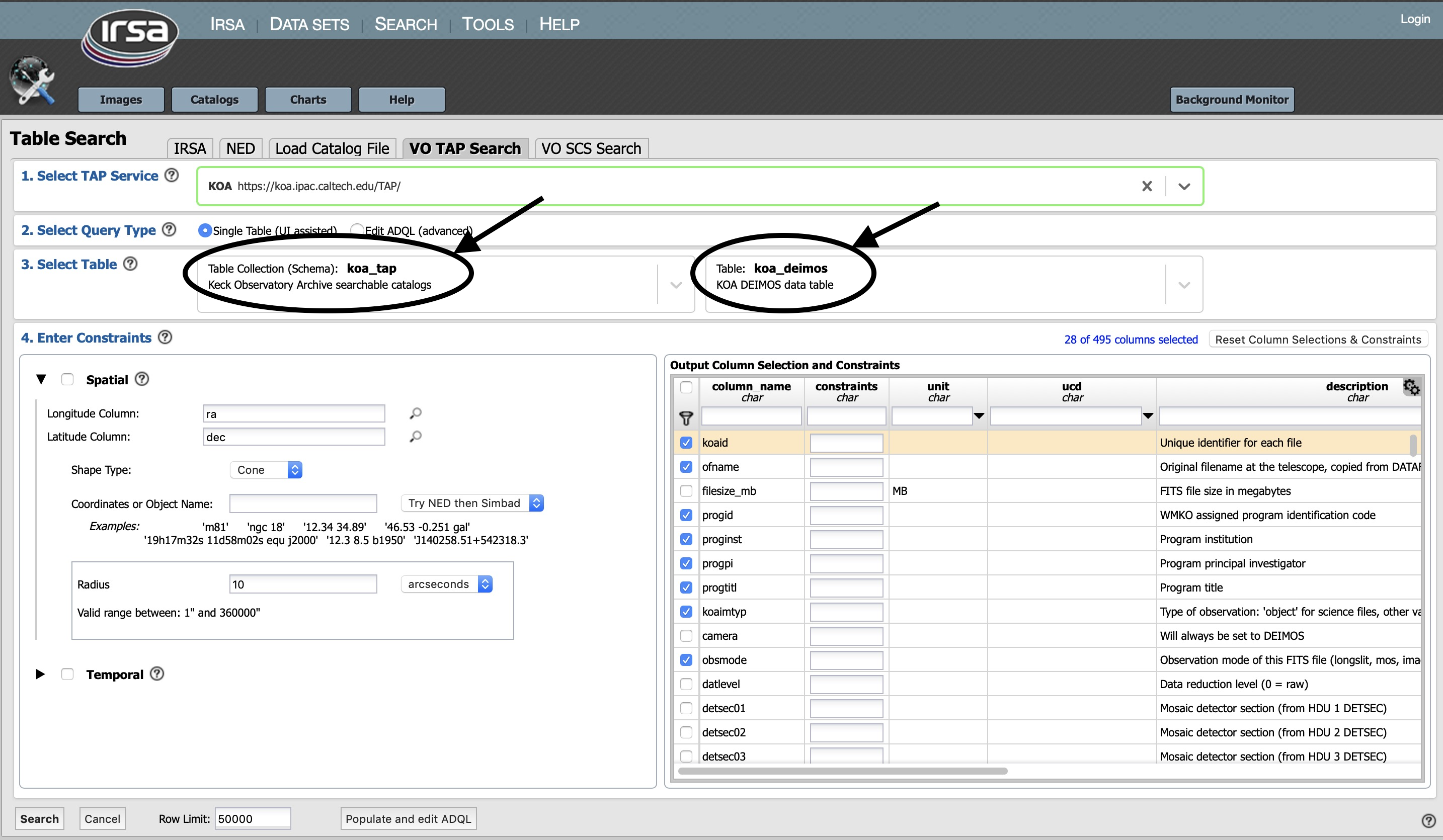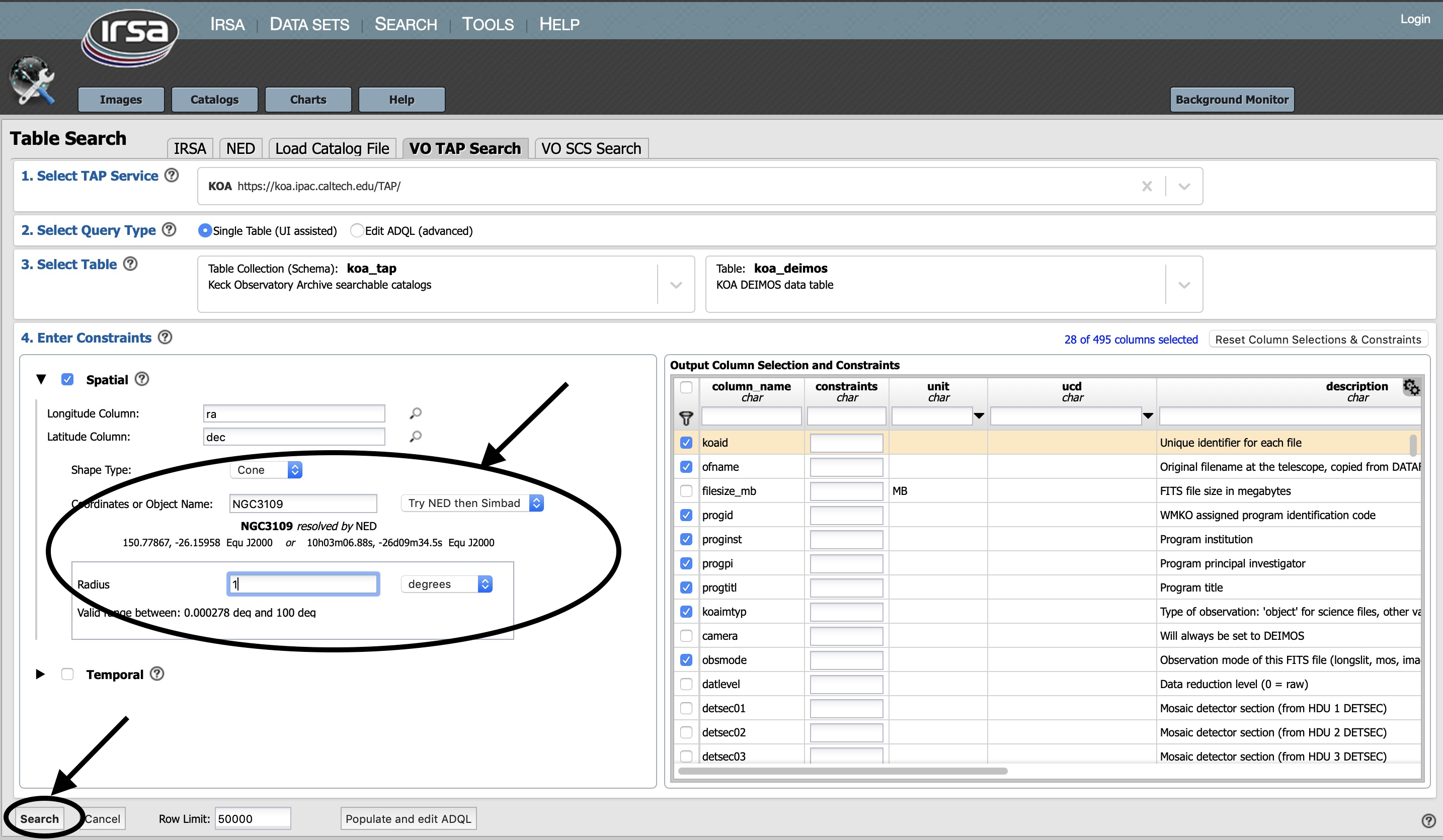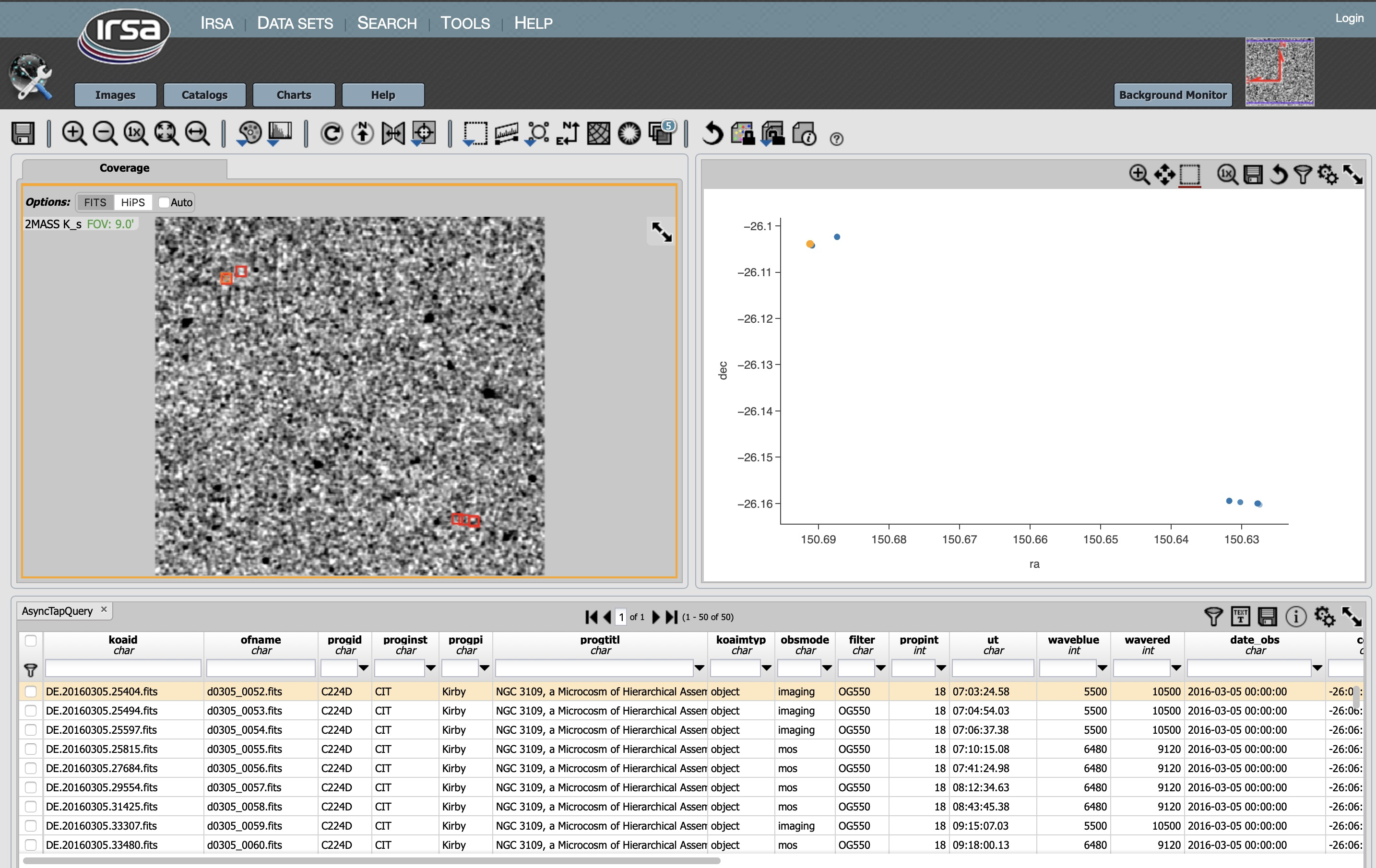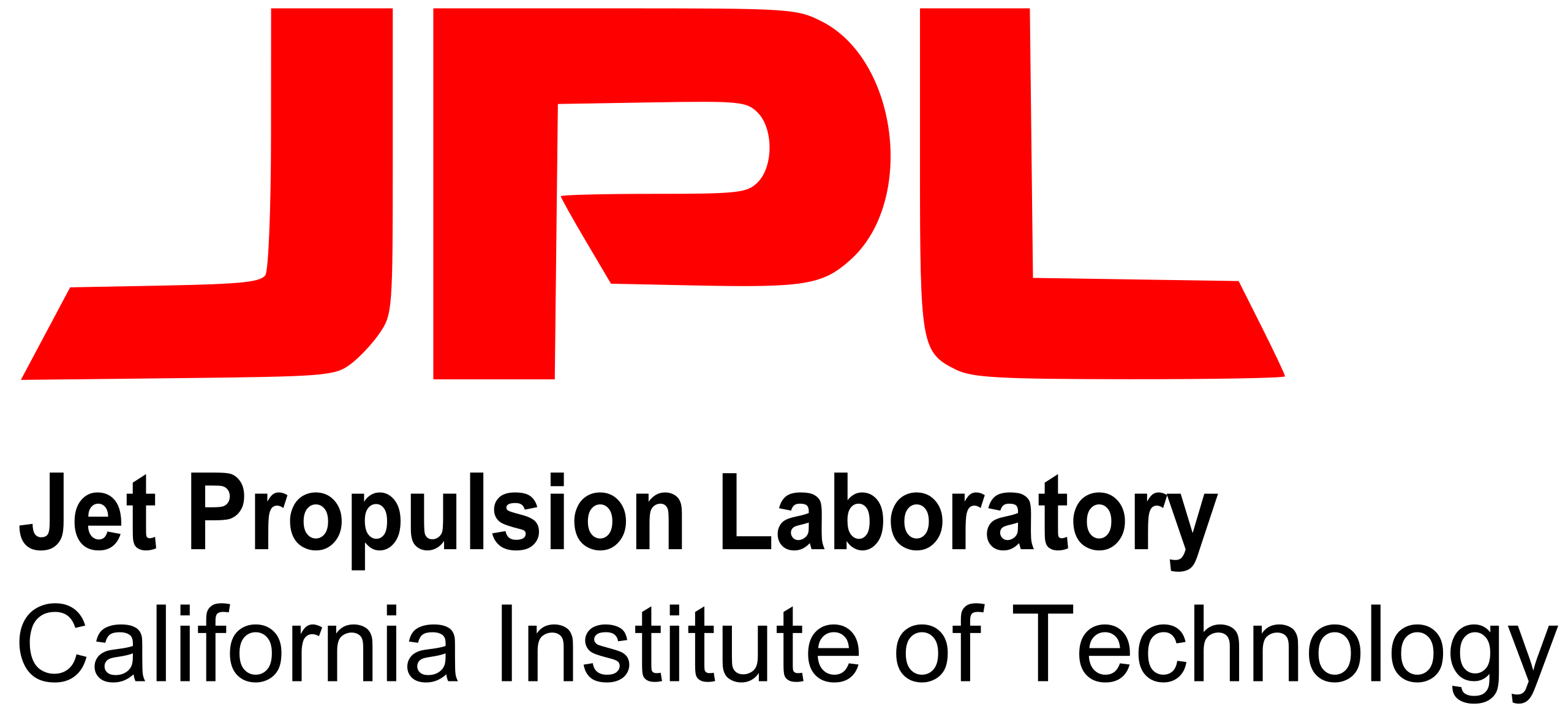Python and TAP Access to KOA Data
KOA provides a Python client, PyKOA, to discover and access raw (level 0) data for all instruments and quick-look extracted (level 1) files for five instruments for which an automated pipe pipeline available: HIRES, NIRSPEC, NIRC2, OSIRIS, and LWS. The reduced data are intended as a guide to the science content of the data are and not intended for scientific analysis. PyKOA supports access to public and protected data. Note that level 1 data created by pipelines developed under the WMKO Data Services Initiative (DSI) are not yet available through the Python client.
Calls may also be made through widely-used IVOA Table Access Protocol (TAP) clients via nexsciTAP, NExScI's Python based implementation of a TAP-compliant server. The TAP clients support access to public data only.
The database columns names for use in queries
Information regarding the database columns available for PyKOA and TAP queries can be found in the following links:
- DEIMOS Columns
- ESI Columns
- GUIDER Columns (PyKOA n/a)
- HIRES Columns
- KCWI Columns
- KPF Columns
- LRIS Columns
- LWS Columns
- MOSFIRE Columns
- NIRC Columns
- NIRC2 Columns
- NIRES Columns
- NIRSPEC Columns
- OSIRIS Columns
- Download all instrument keywords CSV files
PyKOA: A Python Interface to KOA Data
PyKOA offers provides access to public raw science and calibration files acquired with any of the KOA instruments. Keck Observatory PIs may use the KOA credentials already assigned to them with PyKOA to access their protected data.
PyKOA also enables a rich variety of searches, including cone, box, polygon, or all-sky spatial searches; temporal searches; searches on program infortmation; and complex searches on multiple attributes, through queries structured in the IVOA Astronomical Query Language (ADQL).
Functionality For End Users
PyKOA supports the following methods for accessing KOA science and calibration data:
- Query by date or date range (with examples for each file format).
- Query by position.
- Query by object.
- Query by program information.
- Query by by combinations of the above search criteria.
- Download raw science and associated calibration files, or a subset of data, corresponding to a collection of metadata.
- General metadata queries in the IVOA Astronomical Data Query Language (ADQL).
(note: not all of the ADQL specifications have been implemented yet) - Queries for protected data (available to Keck PIs only).
- Queries for a moving object searches for observations of an asteroid, comet, planet, or natural satellite by NAIF ID (SPK-ID), or by manually entering the orbital elements. (as of version 1.7.2)
PyKOA writes the output metadata data to an output file, in the IPAC ASCII, VOTable, CSV or TSV data formats.
Installation
PyKOA can be installed from PyPI:
pip install --upgrade pykoa
Requirements
Requires Python 3.6 (or above), plus table read and write functions from Astropy. We have tested with Astropy 4.0.1. We recommend using the Anaconda Python distribution.
Jupyter Notebooks
These Jupyter Notebooks provide examples of the methods supported by PyKOA, and examples of how Keck PIs may login and access their protected data.
TAP Clients
KOA supports synchronous and asychronous queries queries to three widely used IVOA Table Access Protocol (TAP) clients: PyVO, TOPCAT and IRSA Viewer. Protected (user-proprietary) data at KOA are inaccessible through these clients, as they do not support the security cookies required to access private data at KOA. PIs wishing to access their protected data through a Python API should use PyKOA. (The TAP+ client operating under astroquery has been deprecated and KOA queries to it are no longer supported).
PyVO
PyVO is a Python package that provides access to remote data and VO-compliant services.
Jupyter Notebooks
These Jupyter Notebooks provide examples of the methods supported by PyVO.
TOPCAT
TOPCAT is an interactive graphical viewer and editor for tabular data. It provides most of the capabilities astronomers need for analysis and manipulation of source catalogues and other tables. It is a stand-alone Java application that uses Virtual Observatory (VO) standards to access and integrate distributed data.
The screenshots below show how to query for HIRES data in TOPCAT; substitute your favorite instrument for HIRES.
- Download the jar file from the TOPCAT web site and open the application. Select "Load Table" from the file menu and then choose "Select From":

- At the bottom of the window, enter the URL of the TAP service (https://koa.ipac.caltech.edu/TAP) and click "Use Service"

- In the Use Service tab, enter the SQL query in the window near the bottom and hit "Run Query":

- When the query has run, you will see a window that reports the status of the query:

- Double click on a table in Table List on the left side of the window to visualize the table:

- Now you are ready to analyze the results in TOPCAT.
Note: If you get a "metadata not found" message when you run the query, Select "VO-> Table Service Access Protocol" from the TOPCAT main menu, then Select "TAP -> Metadata Acquisition -> TAP_SCHEMA-C"
IRSA Viewer
IRSA Viewer is a general purpose tool that offers discovery of and subsquent interaction with images, catalogs and time series data. To access KOA data:
- On the main IRSA Viewer page, Select the "Catalogs" tab
- Select the "VO TAP Search" tab
- In "Select TAP Service", select "KOA https://koa.ipac.caltech.edu/TAP/"
- In "Select Query Type", select "Single Table"
- In "Select Table", select Table Collection (Schema): koa_tap, Table: select the KOA instrument table
- Under "Enter Constraints", enter your search constraints and then select "Search"
Select KOA TAP service:

Select koa_deimos table:

Under "Enter Constraints," select Spatial, and enter NGC3109 in "Coordinates or Object Name". NED will resolve the position of this galaxy. Under "Radius", select degrees and then enter "1". Then click "Search" at the bottom left of the page.

The return page will include a table of metadata observations at the bottom, a 2MASS image centered on the returned observations, and a scatter plot of the positions of the observations. Visit the return page to learn about functions for interacting with the data.

Please acknowledge the use of KOA by including this text in your publications:
This research has made use of the Keck Observatory Archive (KOA), which is operated by the W. M. Keck Observatory and the NASA Exoplanet Science Institute (NExScI), under contract with the National Aeronautics and Space Administration.
Please also acknowledge the PI(s) of datasets that have been obtained through KOA, and please contact the KOA Help Desk if you publish archival data.
If your research uses data reduced by the DEIMOS, KCWI, MOSFIRE, or NIRES PypeIt DRP, please use the PypeIt Citation.
If your research uses data reduced by the KPF DRP, please use the citation as described in the README.md.
Privacy Policy Image Use Policy
The Keck Observatory Archive (KOA) is a collaboration between the NASA Exoplanet Science Institute (NExScI) and the W. M. Keck Observatory (WMKO). NExScI is sponsored by NASA's Exoplanet Exploration Program, and operated by the California Institute of Technology in coordination with the Jet Propulsion Laboratory (JPL).




